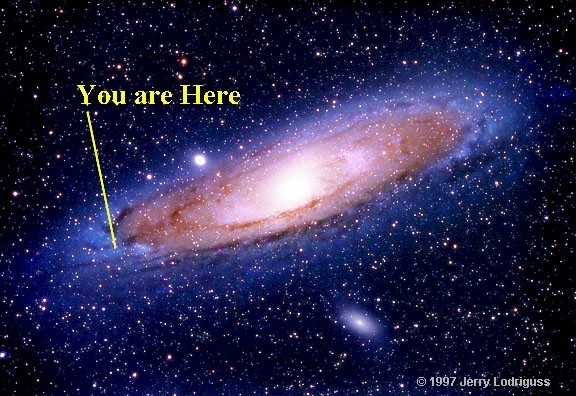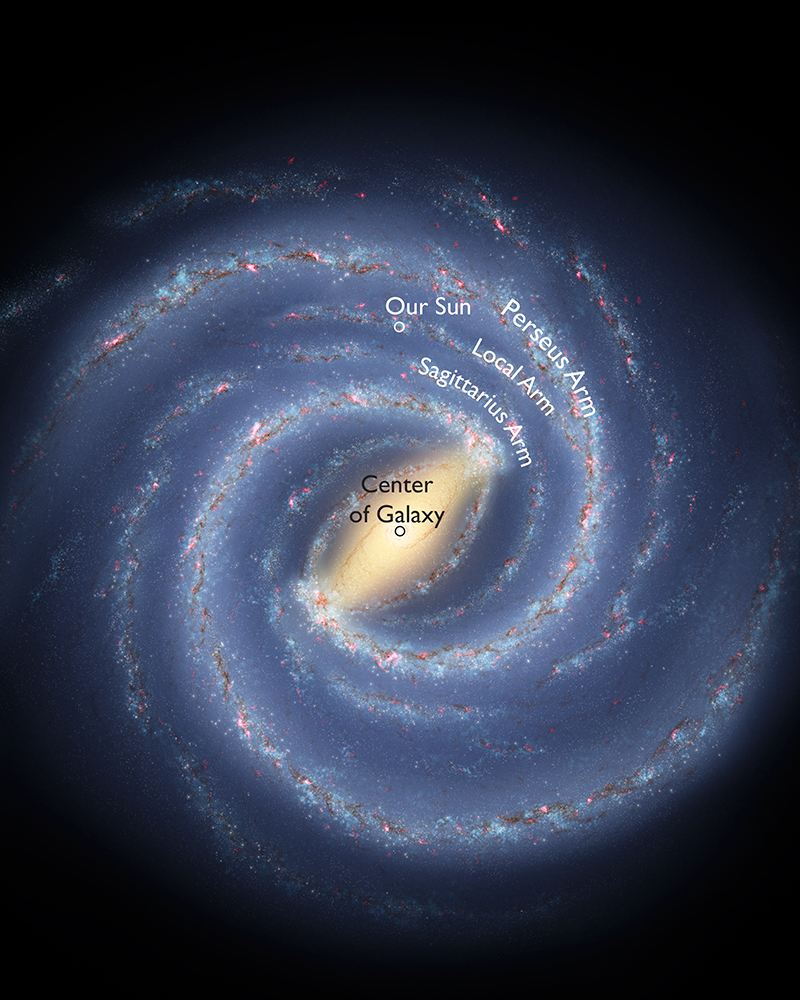General Discussion
Related: Editorials & Other Articles, Issue Forums, Alliance Forums, Region ForumsDU astronomers, a Milky Way question.
I've been seeing lots of photographs of the Milky Way at night from different locations in the world. When we see a picture of the galaxy it appears as a long strip of stars across the sky. Are we on earth viewing the MW from its side? If you flipped what we see around would it appear more like the traditional record like disk with a defined center?
Might be a stupid question but one that came to mind as I've been looking at these pictures. What would it look like from another vantage point than ours? Do we know?
kentuck
(111,095 posts)From some photos I have seen.
Drale
(7,932 posts)what your seeing is light from millions of stars on the edge of our galaxy being combined into what looks like one band of milky light.
Skidmore
(37,364 posts)I'm just having trouble visualizing.
Drale
(7,932 posts)jberryhill
(62,444 posts)
We are in an arm of a spiral galaxy.
We can't really see the "center" of the galaxy from here, since it is like trying to see someone through a crowd.
Here is a crowd of people:

Of course, nobody in that crowd of people has a view of the crowd, since they are IN it. What you see when you are in a crowd is not the crowd, but whomever intersects your line of site in any direction in the plane of the crowd:

wandy
(3,539 posts)SteveG
(3,109 posts)
Gravitycollapse
(8,155 posts)There is a super massive black hole in the center of our galaxy. It is sucking in matter. But this infalling matter, because of physics, spirals around instead of simply falling straight in. As the matter speeds up and compresses, it produces an immense amount of light. Hence, the black hole is blocked by an intense ball of light emitted from infalling matter.
laundry_queen
(8,646 posts)the streak across the sky is the particular 'arm' of the spiral galaxy that our sun resides in. Not sure how true that is - I can see what you are saying about the galaxy being on its side. I honestly don't know.
jbond56
(403 posts)opiate69
(10,129 posts)If we were able to get far enough above or below the galactic plane, it would appear as a giant spiral with arms of stars and dust radiating around it. Our solar system is in one if these arms, more or less lined up on the galactic plane. Here's a good site for further info.
http://www.atlasoftheuniverse.com/galaxy.html
immoderate
(20,885 posts)If the Milky Way were a record, we would be on one of the outer tracks.
If viewed from (way) above the ecliptic, it would appear as a disc, with spiral arms, and probably a huge black hole at its center. ![]()
--imm
MineralMan
(146,308 posts)It shows our solar system's location in the galaxy. We can only see any of it from a side view. We're looking at the spiral arm, toward the center of the galaxy. We can't actually see the central part, though, due to the density of the stars in the spiral arm.

opiate69
(10,129 posts)Otherwise, spot-on.
MineralMan
(146,308 posts)We can, however, see parts of the spiral arm. Lots of matter between us and the galactic center. Humans won't see the galactic center unless we send a starship perpendicular to the galactic plane, and that's not happening. If we every send starships out, they'll be heading for relatively nearby stars.
opiate69
(10,129 posts)And even then, the galactic center is such a violent and unimaginably radioactive place, I can't imagine ever getting within a few hundred light years of it. What a trip it could be, though...
ismnotwasm
(41,980 posts)the thought is that one is in center the center of most galaxies? Sometimes more than one and sometimes incredibly massive?
opiate69
(10,129 posts)There is a super-massive black hole in the center of our - and most spiral - galaxy.
http://en.m.wikipedia.org/wiki/Sagittarius_A*
NYC_SKP
(68,644 posts)I'm 5,325,787,445th from the left.
![]()
MineralMan
(146,308 posts)I did. I can see you in your underwear through the window! haha
NYC_SKP
(68,644 posts)So much for universal standards of privacy.
![]()
kentuck
(111,095 posts)longship
(40,416 posts)We see it as a band because that's the only way we can see it. Unfortunately for us, some of the best views are best viewed from the Southern Hemisphere.
Oh, to live near the equator where one gets to see the whole sky.
Tierra_y_Libertad
(50,414 posts)JustABozoOnThisBus
(23,340 posts)So astronomy is history, of a sort.
opiate69
(10,129 posts)The farthest stars we can see with our naked eye are somewhere around 4,000 light years away.. depending on conditions, location, etc. Considering the 5 - 10 billlion year or so average life span of a typical star, it's unlikely that many of the stars we see have burned out or gone nova since the light left them. Also, analysis of the light we do see enables us to determine where in it's life cycle a star is. A star like Betelgeuse may possibly have gone nova already, since we know it is in the final stages of it's life cycle. But not that many of the visible stars are in that state as far as we can tell.
bettyellen
(47,209 posts)make one pause.
opiate69
(10,129 posts)roamer65
(36,745 posts)...you are looking at photons that are around 2.5 million years old.
roamer65
(36,745 posts)Last edited Mon Jun 3, 2013, 07:51 PM - Edit history (2)
Remember we're only about 26,000 light years from galactic center, but star longevity ranges from hundreds of millions to billions of years. Our sun, Sol, is currently about 4.6 billion years old. Most of what you see in our northern hemisphere sky is within our galaxy and has a very long duration to it. Some of our biggest candidates right now for major change are Betelgeuse in Orion, "La Superba" in Canes Venatici and Mu Cephei in Cepheus. They are red giants getting ready lose their outer gas layers. I keep hoping that I live long enough to see one of them go.
CrispyQ
(36,464 posts)This application is really cool. Scroll with your mouse or move the grey button on the scale bar under the image. http://scaleofuniverse.com/
Of all the Hubble images, this remains my favorite.

roamer65
(36,745 posts)Their position in the sky depends a lot on our 23 deg tilt and position in our orbit and obviously where you are on earth. Right now the Sagittarius arm is just starting to come up in the eastern sky in the evenings and stays low on the southern horizon for the continental United States for the summer. During the American summer the Cygnus arm usually comes in directly overhead as well. By winter the Orion arm is in the south for most in the US. Orion is acutally in the sky in the daytime right now and if I align my telescope and let it run into the daylight I can see stars like Betelgeuse, Rigel and Mintaka. Very easy to see Sirius in Canis Majoris during the daytime in a scope as well.
If you see one of the big mosaics of the galaxy, remember those have to be assembled from photographs of the Northern and Southern Hemisphere skies. The best I have been able to see into the Southern Hemisphere from my +42 and +43 deg N viewing locations is around -42 deg N, NGC6231 aka the Scorpius jewel box. Obviously the further south I go the more I would get to see.
DreamGypsy
(2,252 posts)...at least according to Alberto Sanna of the Max Planck Institute. Reported on Universe Today: Our Place in the Galactic Neighborhood Just Got an Upgrade

But perhaps our suburb isn’t as quiet or lowly as we thought. A new model examining the Milky Way’s structure says our “Local Arm” of stars is more prominent than we believed.
“We’ve found there is not a lot of difference between our Local Arm and the other prominent arms of the Milky Way, which is in contrast what astronomers thought before,” said researcher Alberto Sanna, of the Max-Planck Institute for Radio Astronomy, speaking today at the American Astronomical Society’s annual meeting in Indianapolis, Indiana.
<snip>
As part of the BeSSeL Survey (Bar and Spiral Structure Legacy Survey) using the Very Long Baseline Array (VLBA), astronomers are able to make more precise measurements of cosmic distances. The VLBA uses a network of 10 telescopes that work together to figure out how far away stars and other objects are.
<snip>
“I would say yes, that’s a nice conclusion to say we are more important,” Sanna told Universe Today. “But more importantly, we are now mapping the Milky Way and discovering how the Milky Might appear to an outside observer. We now know the Local Arm arm is something that an observer from afar would definitely notice!”
Hmmm. Good and bad. Probably means the rent will be increasing substantially.
If you would like more details, you can get a preprint of the findings in the Astrophysical Journal here: On the Nature of the Local Spiral Arm of the Milky Way (42 pages, pdf)
ladjf
(17,320 posts)Last edited Mon Jun 3, 2013, 06:27 PM - Edit history (1)
Here is an article with illustrations.
http://www.enchantedlearning.com/subjects/astronomy/solarsystem/where.shtml
DreamGypsy
(2,252 posts)...so the radius is ~50 to 60 KLY. The solar system is ~23 to 35 KLY from the periphery of the galactic spirals.
The Milky Way is ~1 KLY 'thick' and I recall that the solar system is closer the galactic 'south' pole than the galactic 'north' pole, so were pretty close ( < 500 LY) to an edge going that way.
Response to Skidmore (Original post)
CrispyQ This message was self-deleted by its author.
Cronus Protagonist
(15,574 posts)Gravitycollapse
(8,155 posts)At the center of that spot is a super massive black hole.
When you look at the strip across the sky, you are seeing a side profile of the spiral galaxy. Our solar system is about 30,000 light years from the center.
roamer65
(36,745 posts)Just off to the right of the tip of the spout and up a little bit is Sgr A*, the radio wave source believed to be galactic center. When you look in that region you are generally looking at galactic center.
DonRedwood
(4,359 posts)What can go wrong with that.
(I didn't have an answer for your space question, so I discussed the other Milky Way)
Response to Skidmore (Original post)
Katashi_itto This message was self-deleted by its author.